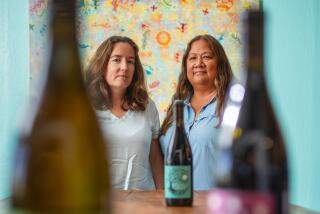Fighting to Protect Sherry Name : Spain Seeks Limits to Using Name of Locally Made Wine
- Share via
JEREZ DE LA FRONTERA, Spain — People here say if it isn’t made from grapes grown on a 20,000-acre triangle of hills in this provincial town or places nearby, it isn’t Sherry-- jerez in Spanish and xeres in French.
The use of the term Sherry (jerez or xeres) is one of the hundreds of issues in Spain’s negotiations to join the European Common Market.
For Jerez de la Frontera and other parts of southwestern Spain, it is the only issue.
Sherry, the name the English gave to the wine, has been produced in this area since the Romans came more than 2,000 years ago. It is now the economic backbone of the area.
Under a 1935 Spanish law only those wines made from grapes grown here and in surrounding areas can be called Sherry, jerez or xeres.
But outside Spain, according to Luis Breton, managing director of the Sherry Exporters Assn., “any boiled-down grape juice can carry the name.”
What has aroused the Sherry exporters’ concern is a statement they consider a reversal of the Common Market’s previous position on the protection of wine names--the controlled appellation of origin, in official parlance.
Issued a Paper
On Dec. 18, 1984, the Common Market’s Council of Ministers issued a paper saying they didn’t feel it was necessary to protect the name Sherry against abuse by products marketed solely in Britain and Ireland, which are Common Market members.
But it happens that Britain and Ireland are the world’s leading Spanish-Sherry drinkers; they consumed about 60 million quarts of it last year.
The producers and exporters in the Jerez area--some of whom descend from English and Irish families with names like Osborne, Byass and Croft--don’t want drinkers in Britain to turn to something called “Cyprus Sherry” or “Irish Sherry” or even “British Sherry.”
It was the British who first applied the term Sherris-- distorting the Spanish pronunciation of Jerez--in 1608 to the Spanish drink. It eventually became Sherry.
In the late 18th Century, British shippers put Jerez on the map in their search for an alternative to French wines during the Napoleonic wars.
In an interview in his office in the House of Wine here, Breton claimed that British and Irish distillers now are producing their drink from dehydrated juice made of grapes grown on the Mediterranean island of Cyprus or purchased from French growers, who are subsidized by the Common Market.
He said the distillers add water, industrial alcohol and artificial coloring to the juice and sell it at half the cost of Spanish Sherry.
“It is neither wine, nor British nor Sherry,” Breton said.
In 1979, Breton added, the Common Market’s Economic Commission came out in support of strong protection of appellations of origin. He said it was difficult for the exporters to find an explanation for the reversal in December, except “the usual British and Irish opposition in community matters.”
Spain was the first wine-producing country in the world to protect appellations of origin through legislation. The French followed six months later, in July 1935, with their own law.
Although Spain’s eventual entry into the 10-member Common Market--scheduled for Jan. 1, 1986--does not hinge on who can call what Sherry, wine-related matters are of vital importance in the European community where France, Italy and Greece are apprehensive about Spanish competition.
At a luncheon in Madrid to stimulate Spanish exports, Prime Minister Felipe Gonzalez said he considered the Sherry appellation issue to be “extremely serious.”
Although Sherry exports quadrupled in the last 25 years to around 34.3 million gallons last year, Breton said, they have leveled off after peaking five years ago.
In Jerez, nearby Puerto de Santa Maria and Sanlucar de Barrameda wineries cover entire city blocks and the health of the Sherry trade is everybody’s business.
But unemployment is higher in this area than in other parts of Spain, whose national jobless rate is 20%, the highest in Western Europe.
Not counting the British imitations, Breton said, Sherry’s biggest competitors are vermouth, drunk before meals, and Port, drunk after.
Spain now consumes about 15% of the Sherry it produces, placing it third in world consumption behind the United Kingdom and the Netherlands.
The best of Spanish brandy is made from distilled Sherry. Breton said Spanish distillers avoid using the term Cognac out of respect for the French appellation, even though the drink is popularly known throughout Spain as Conac.
More to Read
Sign up for Essential California
The most important California stories and recommendations in your inbox every morning.
You may occasionally receive promotional content from the Los Angeles Times.













